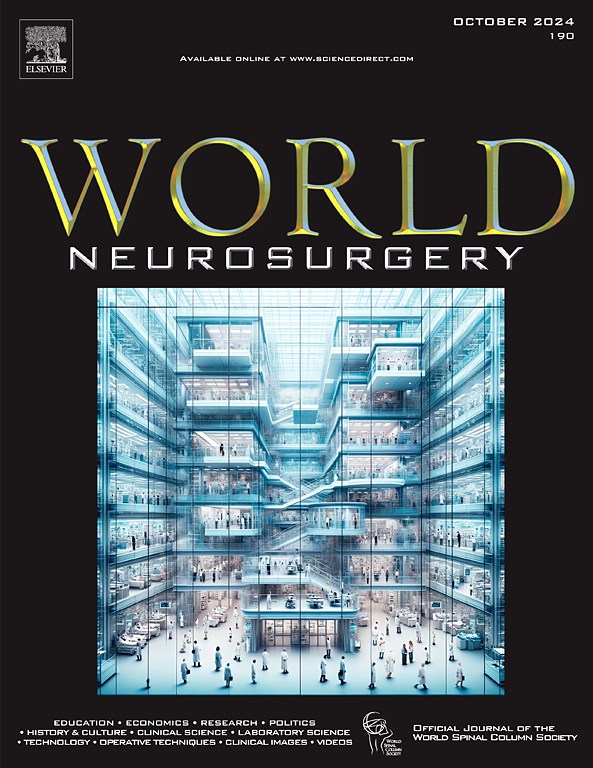三维放射组学和机器学习预测脊髓型颈椎病椎板成形术术后结果:临床放射组学模型。
IF 2.1
4区 医学
Q3 CLINICAL NEUROLOGY
引用次数: 0
摘要
目的:本研究旨在探索一种基于三维颈椎重建、放射组学特征提取和机器学习的方法,建立脊髓型颈椎病(CSM)患者术后预后预测模型。它还评估了不同的颈椎脊髓分割策略和机器学习算法的预测性能。方法:回顾性分析2017年1月至2022年12月行后路单门椎板成形术的126例CSM患者。应用三种不同的颈脊髓分割策略(最窄段、手术段和整个颈脊髓C1-C7)对术前MRI图像进行放射组学特征提取。临床预后良好定义为术后JOA恢复率≥50%。通过比较8种机器学习算法的性能,选择了最优的颈椎脊髓分割策略和分类器。随后,将临床特征(吸烟史、糖尿病、术前JOA评分、cSVA)与放射组学特征相结合,构建临床-放射组学预测模型。结果:在三种脊髓分割策略中,基于最窄段的SVM模型效果最佳(AUC=0.885)。其中,吸烟史、糖尿病、术前JOA评分、cSVA是预测预后的重要指标。当临床特征与放射组学特征相结合时,融合模型在测试集上取得了优异的性能(准确率=0.895,AUC=0.967),明显优于单独使用临床模型或放射组学模型。结论:本研究验证了三维放射组学结合机器学习预测脊髓型颈椎病术后预后的可行性和优越性。以最窄段为基础的放射组学特征与临床特征相结合,可获得高度准确的预后预测模型,为临床评估和个性化治疗决策提供新的见解。未来的研究需要进一步验证该模型在多中心、大样本队列中的稳定性和普遍性。本文章由计算机程序翻译,如有差异,请以英文原文为准。
Three-Dimensional Radiomics and Machine Learning for Predicting Postoperative Outcomes in Laminoplasty for Cervical Spondylotic Myelopathy: A Clinical-Radiomics Model
Objective
This study aims to explore a method based on three-dimensional cervical spinal cord reconstruction, radiomics feature extraction, and machine learning to build a postoperative prognosis prediction model for patients with cervical spondylotic myelopathy (CSM). It also evaluates the predictive performance of different cervical spinal cord segmentation strategies and machine learning algorithms.
Methods
A retrospective analysis is conducted on 126 CSM patients who underwent posterior single-door laminoplasty from January 2017 to December 2022. Three different cervical spinal cord segmentation strategies (narrowest segment, surgical segment, and entire cervical cord C1–C7) are applied to preoperative magnetic resonance imaging images for radiomics feature extraction. Good clinical prognosis is defined as a postoperative Japanese Orthopaedic Association (JOA) recovery rate ≥50%. By comparing the performance of 8 machine learning algorithms, the optimal cervical spinal cord segmentation strategy and classifier are selected. Subsequently, clinical features (smoking history, diabetes, preoperative JOA score, and cervical sagittal vertical axis (cSVA) are combined with radiomics features to construct a clinical-radiomics prediction model.
Results
Among the three cervical spinal cord segmentation strategies, the support vector machine model based on the narrowest segment performed best (area under the curve [AUC] = 0.885). Among clinical features, smoking history, diabetes, preoperative JOA score, and cSVA are important indicators for prognosis prediction. When clinical features are combined with radiomics features, the fusion model achieved excellent performance on the test set (accuracy = 0.895, AUC = 0.967), significantly outperforming either the clinical model or the radiomics model alone.
Conclusions
This study validates the feasibility and superiority of three-dimensional radiomics combined with machine learning in predicting postoperative prognosis for CSM. The combination of radiomics features based on the narrowest segment and clinical features can yield a highly accurate prognosis prediction model, providing new insights for clinical assessment and individualized treatment decisions. Future studies need to further validate the stability and generalizability of this model in multicenter, large-sample cohorts.
求助全文
通过发布文献求助,成功后即可免费获取论文全文。
去求助
来源期刊

World neurosurgery
CLINICAL NEUROLOGY-SURGERY
CiteScore
3.90
自引率
15.00%
发文量
1765
审稿时长
47 days
期刊介绍:
World Neurosurgery has an open access mirror journal World Neurosurgery: X, sharing the same aims and scope, editorial team, submission system and rigorous peer review.
The journal''s mission is to:
-To provide a first-class international forum and a 2-way conduit for dialogue that is relevant to neurosurgeons and providers who care for neurosurgery patients. The categories of the exchanged information include clinical and basic science, as well as global information that provide social, political, educational, economic, cultural or societal insights and knowledge that are of significance and relevance to worldwide neurosurgery patient care.
-To act as a primary intellectual catalyst for the stimulation of creativity, the creation of new knowledge, and the enhancement of quality neurosurgical care worldwide.
-To provide a forum for communication that enriches the lives of all neurosurgeons and their colleagues; and, in so doing, enriches the lives of their patients.
Topics to be addressed in World Neurosurgery include: EDUCATION, ECONOMICS, RESEARCH, POLITICS, HISTORY, CULTURE, CLINICAL SCIENCE, LABORATORY SCIENCE, TECHNOLOGY, OPERATIVE TECHNIQUES, CLINICAL IMAGES, VIDEOS
 求助内容:
求助内容: 应助结果提醒方式:
应助结果提醒方式:


